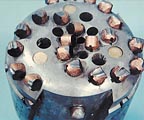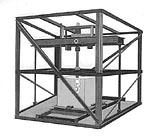
Sandia National Laboratories (SNL), sponsored by the U. S. Department of Energy (DOE) Geothermal Program, conducted research studies in the late 1970s and early 1980s that played a catalytic role in the development of PDC drill bit technology for rock drilling. Today, PDC drill bits account for roughly one-third of the total worldwide rock bit market, with annual sales exceeding $200 million. A PDC bit now holds the all-time record (over 22,000 ft.) for single-run footage in the same well with no bit maintenance or intervening drilling operations. The benchmark for durability has also been set by a PDC bit that achieved the all-time record for cumulative footage by drilling a distance greater than 180,000 feet in 26 runs. Furthermore, the all-time record for penetration rate is attributable to a PDC bit that drilled at more than 2,200 feet per hour. And drilling cost savings derived from PDC bit performance can be dramatic.
Sandia has been conducting cost-shared studies with industry and university partners to improve the hard-rock capability of synthetic-diamond drill bits. These studies aim to extend this technology to a much broader range of applications where significant drilling cost reductions could yet be realized with more rapid rock penetration and longer bit life. Sponsored by the DOE Office of Geothermal Technologies, the Sandia program involves collaborative investigations with industry and university researchers to develop different approaches to bit performance improvement in hard rock. Each project draws upon the unique capabilities of SNL and its partners in one or more of the following technology areas:
- cutter design and manufacturing
- bit modeling and fabrication
- cutter/bit performance and wear testing
- finite element analysis
 Early (circa 1979) polycrystalline diamond compact bits ready for field testing.
Early (circa 1979) polycrystalline diamond compact bits ready for field testing.Early Developments
General Electric (GE) introduced a new type of rock cutter, the PDC cutter, in the early 1970s. This type of cutter employs a thin layer of synthetic polycrystalline diamond that is bonded to a tungsten-carbide stud or blade. The extreme resistance of diamond to abrasive wear makes it possible to use such a cutter in a drag-bit configuration that is inherently more efficient than roller bits in drilling rock.By 1975, drill bits employing PDC cutters were successfully drilling soft-rock formations in the North Sea. DOE’s Geothermal Program subsequently contracted with GE to determine the applicability of PDC bits to geothermal drilling. In 1977, DOE transferred technical responsibility for drilling technology development to SNL.
SNL worked with GE, several bit manufacturers and geothermal operators to design and test PDC bits in the hard-rock formations commonly encountered in geothermal drilling. Several design deficiencies were identified and corrected. Basic bit design principles were developed. Laboratory and field testing demonstrated that PDC bits could effectively drill harder rocks and had a promising market potential.
Numerous PDC bit companies ultimately were established to serve the rapidly growing drilling markets. The laboratory and field tests also demonstrated that a better understanding of PDC bit cutting and wear mechanisms was necessary to further optimize bit designs for more severe environments. Consequently, SNL undertook a number of fundamental studies related to bit hydraulics, cutter temperatures, stresses, wear mechanisms, rock-cutting mechanisms and multiple-cutter interaction. Thermal wear effects were shown to place limitations on the rock strength that could effectively be drilled with current cutter materials.
Two computer codes were developed to assist the industry in the design and operation of PDC bits. The STRATAPAX code allowed the user to design bits such that each cutter on a bit either removed an equal volume of rock or performed an equal amount of work, as specified by the designer. This code was superseded by the PDCWEAR code, which takes a more fundamental approach to bit design. PDCWEAR predicts individual cutter forces and integrates those forces to produce net bit parameters such as weight-on-bit, drilling torque, bending moment and side force. This code also predicts cutter temperatures and wear rates, and it numerically modifies cutter geometries to account for wear. Released in 1986, PDCWEAR is still being used by several bit companies for design activities and for predictions of bit performance and wear. At least one company uses the code to balance its bits for specific rotational speeds. Bits designed with the code have been found to last longer and drill faster, with less whirl and vibration.
 The cutter wear testing facility.
The cutter wear testing facility.Focus on Hard-rock Bits
Improvements in synthetic-diamond bits can potentially reduce drilling costs in a variety of situations. For example, the ability to penetrate hard-rock stringers with PDC bits would greatly reduce the cost of exploratory drilling. Hard-rock PDC and advanced impregnated-diamond bits would cut costs in geothermal drilling and mineral exploration. Introduction of reliable thermally-stable polycrystalline diamond bits would benefit downhole turbine and other high-speed, high-temperature drilling applications.Progress in bit technology is being achieved by means of dedicated efforts made both by Sandia and by its partners. The partnering institutions are directly involved in research and development, including the procurement or manufacture of experimental cutters and bits, implementation of drilling tests, analysis of data and generation of models. SNL, in addition to program management, is conducting cutter performance and wear tests, cutter interaction tests and finite-element thermal and stress analyses of cutters. These tasks utilize unique testing and computational capabilities that are in place at SNL, including: a new Cutter Wear Test Facility for comparative wear testing of synthetic-diamond cutters in an actual drilling environment, an instrumented, linear milling machine for studies of cutter forces and interactions and multidimensional codes for stress and thermal analyses.
Sandia’s program has two primary objectives: 1) to characterize the mechanics and materials involved in the drag-cutting process, and 2) to integrate basic scientific and engineering principles into the optimized design and operation of drill bits. The following projects and associated subtasks address these objectives:
Drag-cutters – This project is devoted to improvements in drag-cutter penetration of hard rock. The research effort encompasses complementary activities in task areas related to PDC cutter behavior in hard rock, advanced cutter development and testing and advanced materials for hard-rock drilling.
Hard rock behavior – Fundamental studies are being conducted to systematically acquire and analyze wear and cutting-force data to determine the influence of basic nonproprietary parameter variations on cutter durability and performance. U. S. Synthetic Corp. and other interested manufacturers participate in this work, supplying PDC cutters with designated geometries and material compositions. Geometric variations involve changes in the diamond-table thickness and chamfer dimensions, alternate diamond-table/substrate interface configurations and bonding techniques and differences in diamond-table surface finish. Material variables include the diamond-particle size distribution and concentration, matrix materials and processing conditions. Results of this work will be jointly published.
Advanced cutter development – Commercial cutters are being evaluated and optimized on the basis of laboratory testing and analysis. Work is under way to upgrade PDC claw cutters that are now featured on standard manufactured bits. Dennis Tool Co. is fabricating optimized PDC claw cutters following design guidance derived from Sandia-generated three-dimensional stress analyses and experimental data regarding wear performance and cutting forces for initial claw-cutter configurations. The optimized claw cutters will be subjected to wear testing.
Advanced cutter materials – Studies are in progress to develop advanced ultrahard cutter materials. Testing is being conducted to examine the bond viability and wear performance of fracture-resistant and microwave-brazed thermally-stable polycrystalline cutters being developed by Technology International Corp. in conjunction with NASA’s Jet Propulsion Laboratory and the Colorado School of Mines. Work also is being done at the New Mexico Institute of Mining and Technology on the formulation of novel ultrahard cutter materials, including aluminum-infiltrated boron suboxide, that are produced by explosive compaction and/or hot pressing.
Bit design and operation – This project is intended to foster innovations in the design and utilization of bits and related hardware appropriate for a hard-rock drilling environment. Improvements in bit design are accomplished, in part, by incorporating technical advances from the cutter research done at Sandia. Arrangements are made, as necessary, for external laboratory and field-test support. This project includes task areas dealing with bit mechanics, PDC bit development and testing and novel bits for hard-rock drilling.
Bit mechanics – Sandia is collaborating with the University of Southwestern Louisiana to characterize the mechanisms of self-induced bit vibration, a phenomenon that is linked to cutter chatter and that leads to reduced penetration rate. PDC cutters are particularly susceptible to impact damage from chatter and bit vibration during hard-rock drilling. This work involves extensive testing on the cutter wear test facility, which has been modified to allow adjustment of the axial compliance and resultant rig vibration spectrum to match conditions observed in the field. Studies of bit dynamics also are being conducted at New Mexico Tech, where cutting-force models have been developed based on the mechanics of the rock fragmentation process and on statistical analyses of force-component measurements obtained from Sandia’s database of linear cutting measurements. These models have been implemented in the PDCWEAR code to predict the downhole behavior of PDC drag bits. Comparisons of code simulations to actual production drilling results from the field validate the models.
PDC bit development and testing – Sandia plans to evaluate the current state of the art for PDC bit performance in hard rock by acquiring commercial bits then field testing them in cooperation with one or more geothermal operators. Working closely with each prospective bit manufacturer, Sandia will identify specific design features to be included in a particular vendor’s bit. After a competitive contract is awarded, the prototype geothermal bits will be fabricated, then subjected to controlled laboratory or field tests. Bit designs showing the most promise in this first evaluation will then be tested during actual production drilling at a geothermal site.
Novel bits for hard rock – Sandia actively promotes the development of innovative bit concepts that show potential for application to the hard-rock drilling environment. These concepts are not restricted to drag bits. A cooperative effort is under way between Sandia, Security DBS, Dynaflow and Terra Tek to develop and demonstrate a PDC bit that employs high-pressure mudjets directed at the cutter/rock interface to enhance the cutting process. Montana Tech is working with Sandia on a separate task to model and develop bi-center PDC bit designs.

Report Abusive Comment